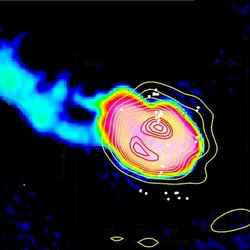
The cloud, where OH maser filament are red and extended methanol filaments are green. Image credit: JIVE Click to enlarge
Astronomers have located a gigantic cloud of methyl alcohol surrounding a stellar nursery. The cloud measures half a trillion km across (300 billion miles), and could help astronomers understand how some of the most massive stars in the Universe are formed. It’s methanol, not ethanol, so you wouldn’t want to drink it if you could reach it.
Astronomers based at Jodrell Bank Observatory have discovered a giant bridge of methyl alcohol, spanning approximately 288 billion miles, wrapped around a stellar nursery. The gas cloud could help our understanding of how the most massive stars in our galaxy are formed.
The new observations were taken with the UK’s MERLIN radio telescopes, which have recently been upgraded. The team studied an area called W3(OH), a region in our galaxy where stars are being formed by the gravitational collapse of a cloud of gas and dust. The observations have revealed giant filaments of gas that are emitting as ‘masers’ (molecules in the gas are amplifying and emitting beams of microwave radiation in much the same way as a laser emits beams of light).
The filaments of masing gas form giant bridges between maser ‘spots’ in W3(OH) that had been observed previously. The largest of these maser filaments is 288 billion miles (463 billion km) long. Observations show that the entire gas cloud appears to be rotating as a disc around a central star, in a similar manner to the accretion discs in which planets form around young stars. The maser filaments occur at shock boundaries where large regions of gas are colliding.
“Our discovery is very interesting because it challenges some long-accepted views held in astronomical maser research. Until we found these filaments, we thought of masers as point-like objects or very small bright hotspots surrounded by halos of fainter emission,” said Dr Lisa Harvey-Smith, who is the Principal Investigator for the study and is presenting results at the Royal Astronomical Society’s National Astronomy Meeting on 4th April.
Since the upgrade of the UK’s MERLIN telescope network, astronomers have been able to image methanol masers with a much higher sensitivity and, for the first time, get a complete picture of all the radiation surrounding maser sources. In the new study, the Jodrell Bank team looked at the motion of the W3(OH) star forming region in 3-dimensions and also measured physical properties of the gas such as temperature, pressure and the strength and direction of the magnetic fields. This information is vital when testing theories about how stars are born from the primordial gas in stellar nurseries.
Dr Harvey-Smith said, “There are still many unanswered questions about the birth of massive stars because the formation centres are shrouded by dust. The only radiation that can escape is at radio wavelengths and the upgraded MERLIN network is now giving us the first opportunity to look deep into these star forming regions and see what’s really going on.”
The many different types of interactions between molecules in star forming regions lead to emissions in many different wavelengths. Future observations of masers at other frequencies are planned to complete the complex jigsaw puzzle that has now been revealed.
Dr Harvey-Smith adds, “Although it is exciting to discover a cloud of alcohol almost 300 billion miles across, unfortunately methanol, unlike its chemical cousin ethanol, is not suitable for human consumption!”
Original Source: RAS News Release
